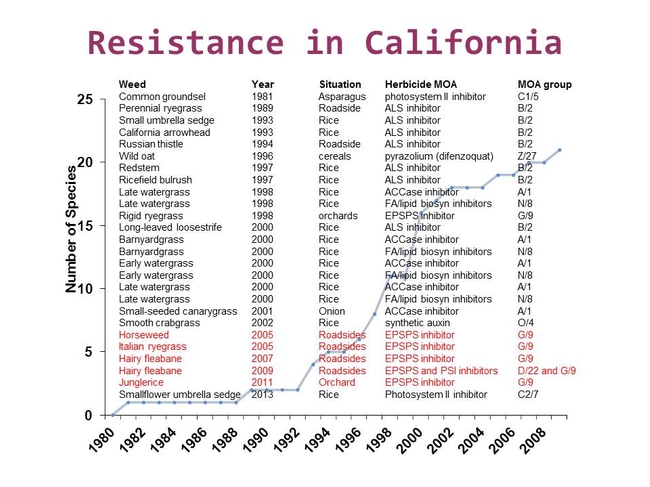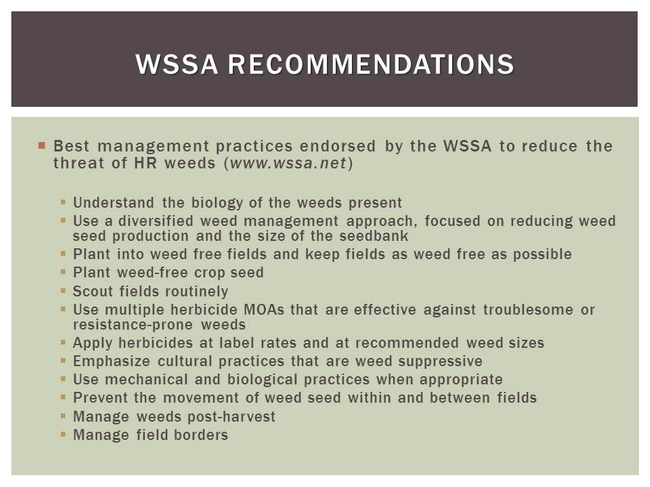Prior to the latter half of the 20th century, weed control in agriculture was achieved almost exclusively through mechanical means (e.g. plowing, cultivating, disking, hoeing, and hand-pulling) (Timmons 1970). The earliest (mid-1800’s to mid-1900’s) investigations into chemical weed management focused, primarily, on the use of inorganic compounds such as sodium chloride, sulfuric acid, sodium arsenite, and copper- and iron-sulfate (Appleby 2005; Timmons 1970). Although some products provided an acceptable level of weed control efficacy, the extensive adoption of these chemicals was decidedly limited (Appleby 2005; Timmons 1970).
The successful debut of 2,4-D (1946), an auxinic compound that allowed for the selective, effective and economic control of broadleaved weeds in cereal crops, helped to accelerate the search for novel, organic (e.g. carbon-containing), agricultural chemicals with specific activities against weeds (Timmons 1970). Many herbicides that are currently used in California agriculture, including diuron (introduced in 1954), propanil (1961), trifluralin (1963), paraquat (1966), glyphosate (1971), pendimathalin (1974), glufosinate (1981) and oxyfluorfen (1981), were developed and released in the decades directly following the advent of a “modern chemical weed control era” (Appleby 2005; Timmons 1970). According to recent EPA estimates (2011), herbicides account for almost half of the total amount if pesticide active ingredients applied in the US.
Despite the widespread adoption and use of herbicides, weeds still persist in agricultural and horticultural systems. Weeds can escape chemical control for numerous reasons, including: incorrect herbicide or rate selection, improper sprayer calibration, clogged nozzles or otherwise malfunctioning equipment, weed size (e.g. too large for control), herbicide applications that are made under less-than-ideal environmental conditions (e.g. too cold, too windy, too wet or too dry), and the evolution and spread of herbicide-resistant weed species. The Weed Science Society of America (WSSA) defines herbicide resistance as “the inherited ability of a plant to survive and reproduce following exposure to a dose of herbicide that is normally lethal”. There are two general mechanisms of herbicide resistance. Target site resistance occurs when the enzyme that is the target of the herbicide becomes "insensitive" to the herbicide that was applied. The loss of sensitivity is usually associated with a mutation in the gene that codes for the enzyme that the herbicide adheres to in the plant. These mutations lead to physical changes in the enzyme’s shape/structure, which prevents herbicide-binding - thus reducing or eliminating herbicidal activity. Alternately, mutations may affect other plant processes in ways that reduce the plant’s physiological exposure to the herbicide; these mutations primarily result in reduced uptake or translocation of the chemical, sequestration, or else more rapid degradation/detoxification. Because the resistance mechanism is not directly related to the herbicide target site, this type of occurrence is called non-target site resistance.
The first occurrences of herbicide resistance were noted in 1957 in populations of spreading dayflower (Commelina diffusa) and wild carrot (Daucus carota), both of which were described as being insensitive to 2,4-D (Hilton 1957; Switzer 1957; Whitehead and Switzer 1963). The next recorded incidence of resistance occurred in 1970 when scientists reported the discovery of common groundsel (Senecio vulgaris) plants in a conifer nursery that were unable to be controlled by simazine (Radosevitch and Appleby 1973; Ryan 1970). Since these initial discoveries, the evolution (and detection) of herbicide-resistant weeds has increased, significantly. To date, more than 200 plant species, worldwide, have developed resistances to one or more herbicide modes of action (Heap 2013). Currently, there are more than 140 herbicide-resistant weed biotypes in the US; California, alone, has at least 20. The majority of California's confirmed resistances have developed in rice production systems, primarily in the Sacramento Valley. More recently, resistance to glyphosate has been discovered in species that are common to perennial cropping systems in California, including: horseweed (Conyza canadensis), hairy fleabane (conyza bonariensis), junglerice (Echinochloa colona), Italian ryegrass (Lolium multiflorum) and rigid ryegrass (Lolium rigidum).
Image credit: Brad Hanson
A list of Best Management Practices (BMPs) to reduce the risks of herbicide resistance was recently (2012) published in a special issue of the journal Weed Science (Norseworthy et al. 2012). According to the WSSA, managers should actively scout their fields and take careful notes about the density and distribution of the species they encounter - within individual growing seasons and across years. Record keeping allows growers to detect changes in weed population size and spread, evaluate herbicide performance and determine if weed-shifts are occurring due to a chemical selection pressure. If an herbicide-resistant species is identified and confirmed, escaped weed(s) should be kept from producing seed. Furthermore, field equipment should be cleaned, regularly to prevent spreading the biotype from one field/orchard/vineyard to another. Crop seed should be certified to ensure that weed pests are not entering production systems in planting materials. It is also important to remember that weed management must extend beyond the crop in both time and space; weeds that emerge post-harvest or along crop borders/roadsides can be as important as those actually in the field during the growing season. Any remaining individuals have the potential to reestablish or enhance the seedbank. In a nutshell, it is key to start clean and stay clean.
Rotation is an important strategy for reducing the intensity of herbicide selection pressure. (Note: it is important to remember that selection pressure, with respect to chemical control measures, is defined as the repeated use of a single herbicide or herbicide mechanism of action within a system. In the absence of additional control strategies, plants that are resistant to a herbicide will note be controlled; if allowed to set seed, their progeny could dominate the local seedbank over time.) Quite often, diversification is an early line of defense against the development of wide-spread herbicide-resistance. In annual production systems, the ability to vary crops, and, therefore, production practices can be an effective means for preventing or delaying herbicide-resistance. For example, the time of crop planting, herbicide availabilities and types of tillage can differ, substantially, among crops; these differences can result in continuously changing environments that may be more difficult for weeds to adapt to. In perennial cropping systems, like orchards and vineyards, crop rotation is impractical. Rotations or tank mixes of herbicides with different modes of action should, therefore, be a part of the management plan to prevent the buildup of weeds that are resistant to a particular mechanism of action. Although herbicide rotations and mixtures are important tools for combating the development of herbicide-resistance in weeds, chemical products cannot be used indiscriminately so as to prevent additional resistances from developing.
Vegetable cropping systems (which rely on older chemistries that often control only a limited numbers of weed species) depend on mechanical cultivation and hand weeding for weed management; these practices are promoted by the WSSA as an effective tool for reducing herbicide selection pressure. Although there has been a trend towards minimum tillage in agronomic cropping systems, many extension personnel have advocated for the use of physical disturbance to manage herbicide resistant weed populations. Cultivation equipment used in orchards and vineyards includes narrow under-vine rototillers, small disk harrows, and a wide assortment of tools designed to cut weeds off just under the soil surface; this equipment must be properly set to make sure roots or tree trunks are not damaged during mechanical weed control. Permanent sod strips are often used in vineyards and orchards to improve access and reduce dust. They can also prevent the establishment of some weedy species, but must be well-managed with mowing to prevent excessive water use.
Image credit: Lynn Sosnoskie
Resistance mitigation seeks to diversify crop production and weed control methods in order to delay the evolution process; this will occur by reducing the selection pressure exerted through the use of herbicides. Target site resistance is conferred by an alteration causing loss of plant sensitivity to herbicides with a specific mechanism of action. One way of dealing with this phenomenon is to switch to an equally effective herbicide that possesses a different mechanism of action. Unfortunately, non-target site resistance may be more difficult to predict or prevent. Because it can involve more ubiquitous biochemical processes that may be shared across herbicides (such as a common degradation route), the use of these chemicals in mixtures or sequences with each other may not be sufficient to avert the development of resistance. Although chemical diversity is an important component of any herbicide-resistance management program, the integration of non-chemical weed control methods (i.e. cultivation, mowing, tillage, crop rotation), whenever possible, is necessary to reduce herbicide-selection pressure. Careful observation and record-keeping can help growers evaluate the success (and failures) of their systems and allow for early detection and prevention of herbicide-resistant species. Herbicides are one of the most effective tools for weed management; however, they must be used judiciously. They should be ‘one of the many tools’ in a weed management toolbox rather than the only tool, or else we risk losing effective herbicides due to the evolution of herbicide-resistant weeds.
Much of this information was originally prepared for a series of IPM articles by B. Hanson, A. Fischer, A. Shrestha, M. Jasieniuk, E. Peachey, R. Boydston, T. Miller, and K. Al-Khatib.
Citations:
Appleby, A. P. 2005. A history of weed control in the United States and Canada: A sequel. Weed Sci. 53:762-768.
Hilton, H. W. 1957. Herbicide tolerant strains of weeds. Hawaiian Sugar Plant. Assoc. Annu. Rep. p 69.
Norseworthy et al. 2012. Reducing the risks of herbicide resistance: Best management practices and recommendations. Special Issue: 31-62.
Radosevich, S. R. and A. P. Appleby. 1973. Relative susceptibility of two common groundsel (Senecio vulgaris L.) biotypes to 6 s-triazines. Agron. J. 65:553-555.
Ryan, G . F. 1970. Resistance of common groundsel to simazine and atrazine. Weed Sci. 18:614-616.
Switzer, C. M. 1957. The existence of 2,4-D resistant strains of wild carrot. Proc. of the North Eastern Weed Control Conference. 11: 315-318.
Timmons, F. L. A history of weed control in the United States and Canada. Weed Sci. 2:294-307.
Whitehead, C. W. and Switzer, C. M. 1963. The differential response of strains of wild carrot to 2,4-D and related herbicides. Can. J. of Plant Sci. 43:255-262.

